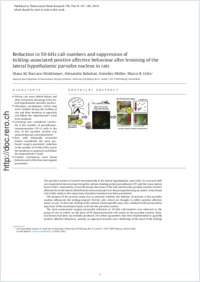Reduction in 50-kHz call-numbers and suppression of tickling-associated positive affective behaviour after lesioning of the lateral hypothalamic parvafox nucleus in rats
- Roccaro-Waldmeyer, Diana M. Anatomy and Programme in Neuroscience, Faculty of Science, University of Fribourg, Switzerland
- Babalian, Alexandre Anatomy and Programme in Neuroscience, Faculty of Science, University of Fribourg, Switzerland
- Müller, Annelies Anatomy and Programme in Neuroscience, Faculty of Science, University of Fribourg, Switzerland
- Celio, Marco R. Anatomy and Programme in Neuroscience, Faculty of Science, University of Fribourg, Switzerland
-
01.02.2016
Published in:
- Behavioural Brain Research. - 2016, vol. 298, Part B, p. 167–180
English
The parvafox nucleus is located ventrolaterally in the lateral hypothalamic area (LHA). Its core and shell are composed of neurons expressing the calcium-binding protein parvalbumin (PV) and the transcription factor Foxb1, respectively. Given the known functions of the LHA and that the parvafox nucleus receives afferents from the lateral orbitofrontal cortex and projects to the periaqueductal gray matter, a functional role of this entity in the expression of positive emotions has been postulated.The purpose of the present study was to ascertain whether the deletion of neurons in the parvafox nucleus influenced the tickling-induced 50-kHz calls, which are thought to reflect positive affective states, in rats. To this end, tickling of the animals (heterospecific play) was combined with intracerebral injections of the excitotoxin kainic acid into the parvafox nucleus.The most pronounced surgery-associated reduction in 50-kHz call-numbers was observed in the group of rats in which, on the basis of PV-immunoreactive-cell counts in the parvafox nucleus, bilateral lesions had been successfully produced. Two other parameters that were implemented to quantify positive affective behaviour, namely, an approach towards and a following of the hand of the tickling experimenter, were likewise most markedly suppressed in the group of rats with bilaterally successful lesions. Furthermore, positive correlations were found between each of the investigated parameters. Our data afford evidence that the parvafox nucleus plays a role in the production of 50-kHz calls in rats, and, more generally, in the expression of positive emotions.
- Faculty
- Faculté des sciences et de médecine
- Department
- Département de Médecine
- Language
-
- English
- Classification
- Biological sciences
- License
- License undefined
- Identifiers
-
- RERO DOC 258902
- DOI 10.1016/j.bbr.2015.11.004
- Persistent URL
- https://folia.unifr.ch/unifr/documents/304847
Statistics
Document views: 71
File downloads:
- cel_rcn.pdf: 203
